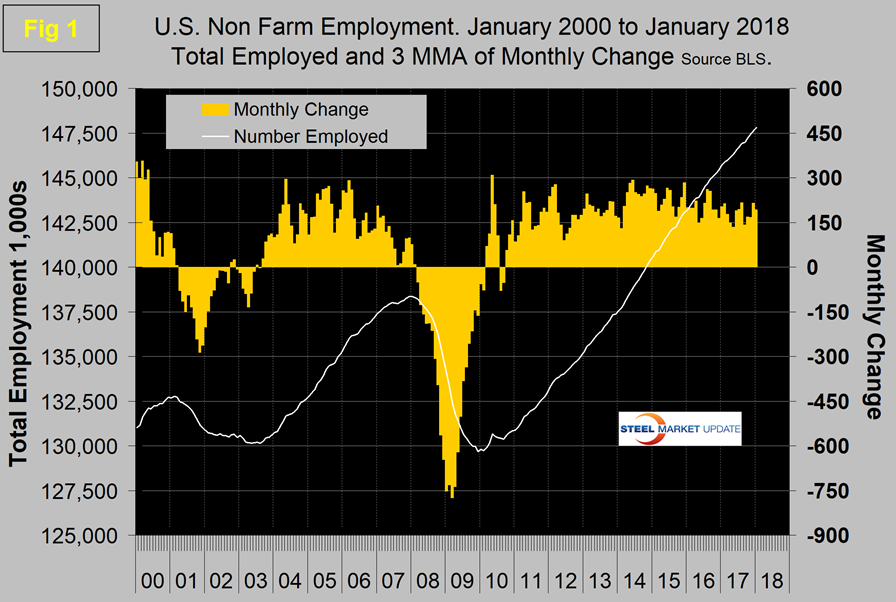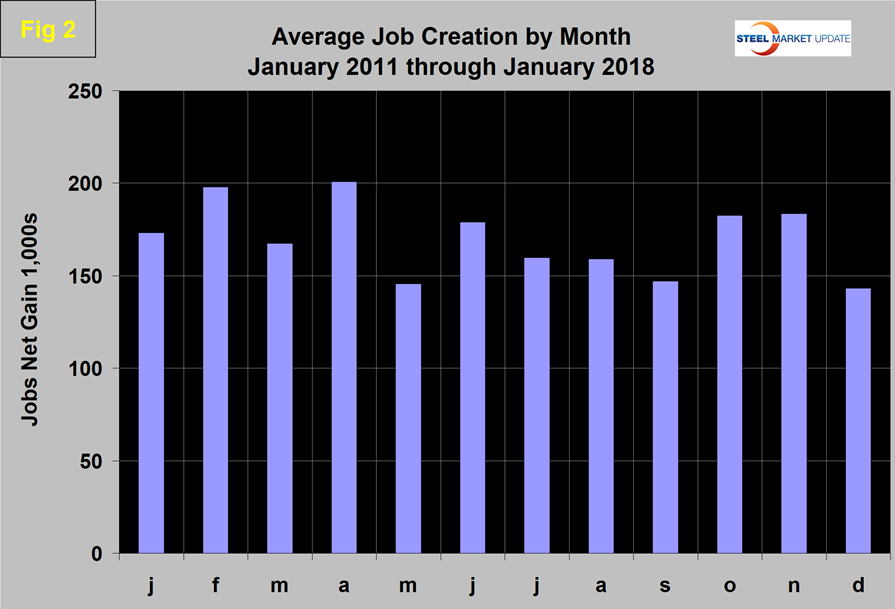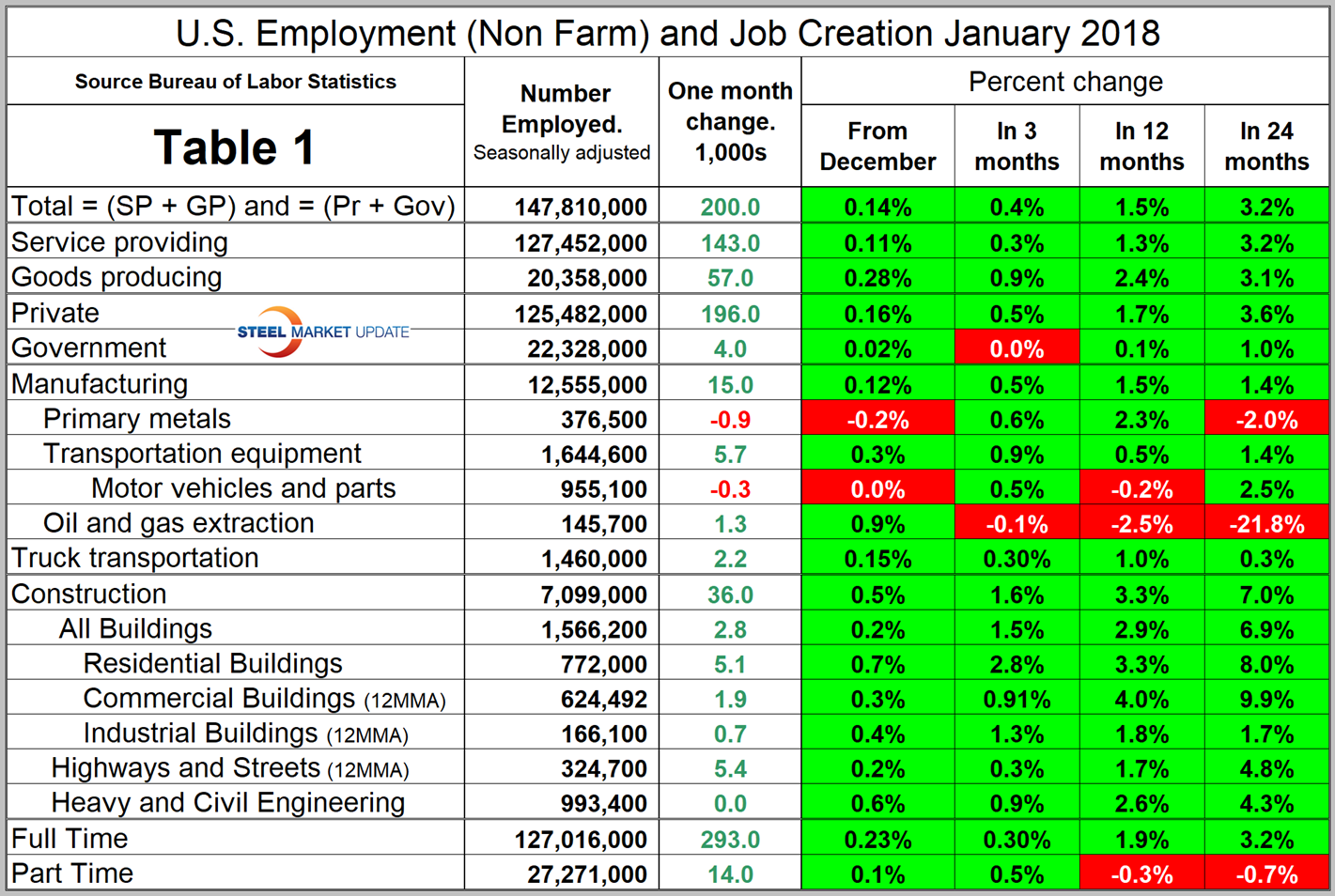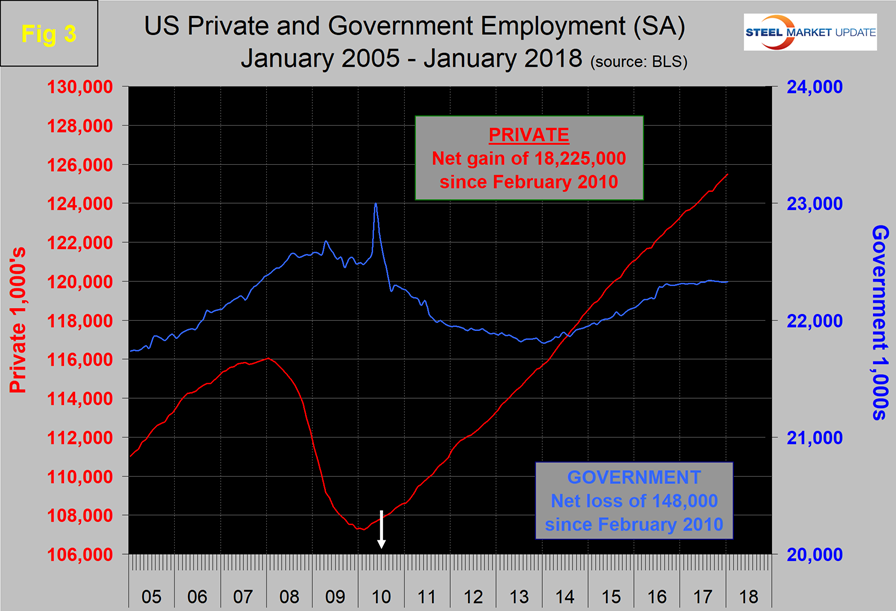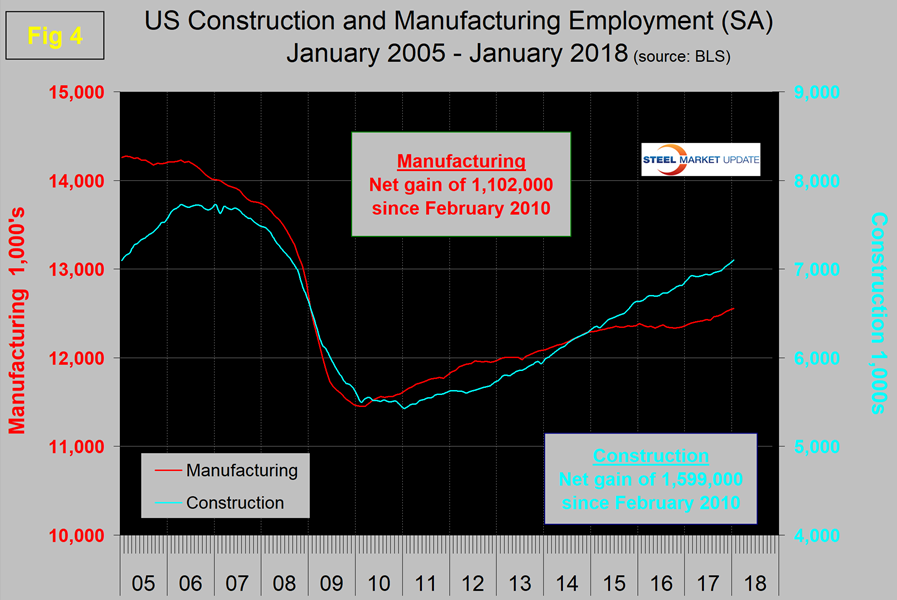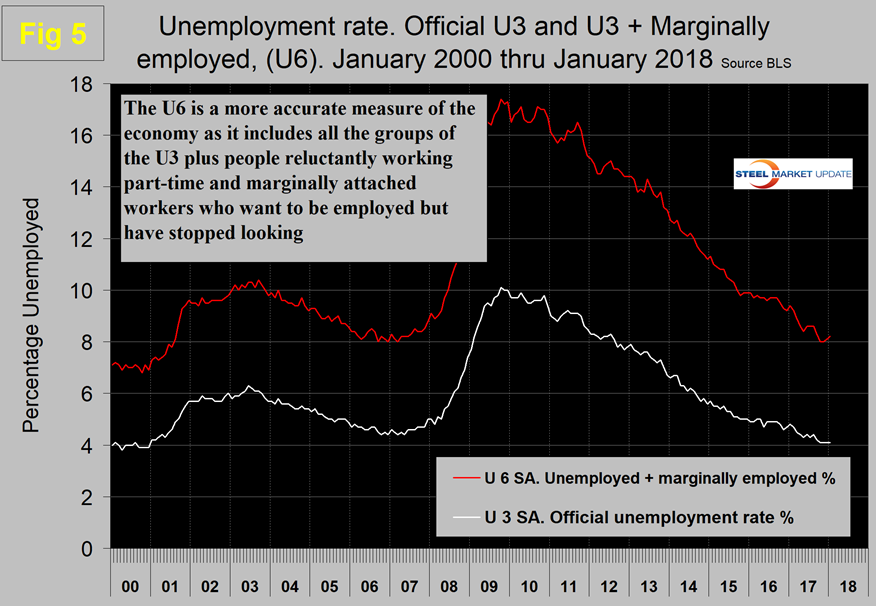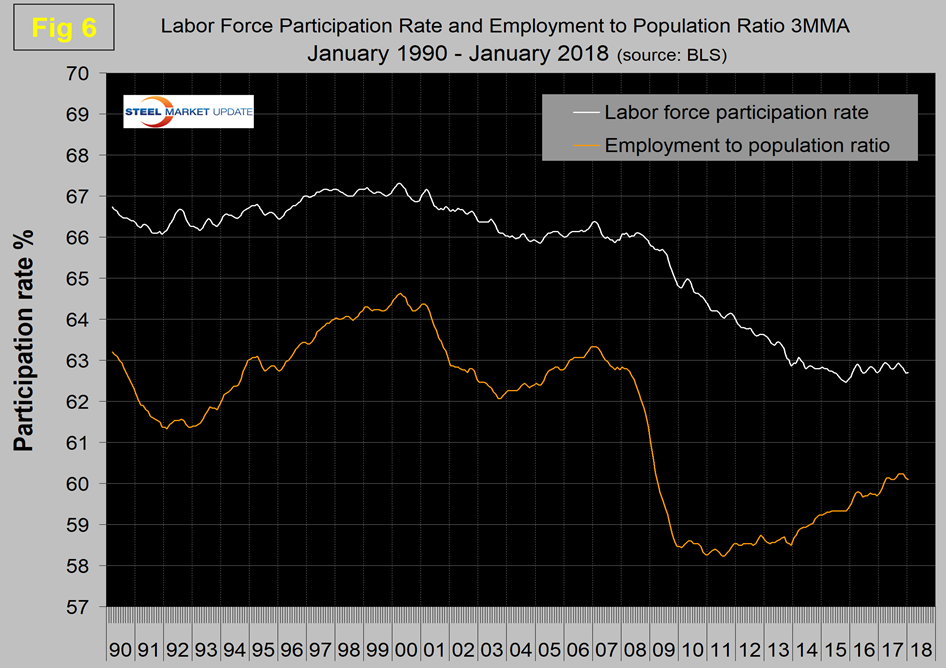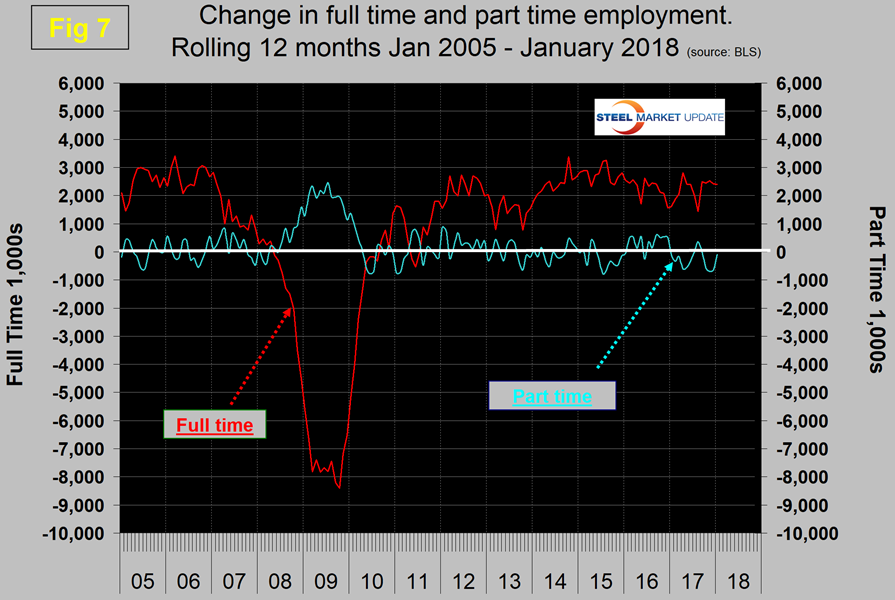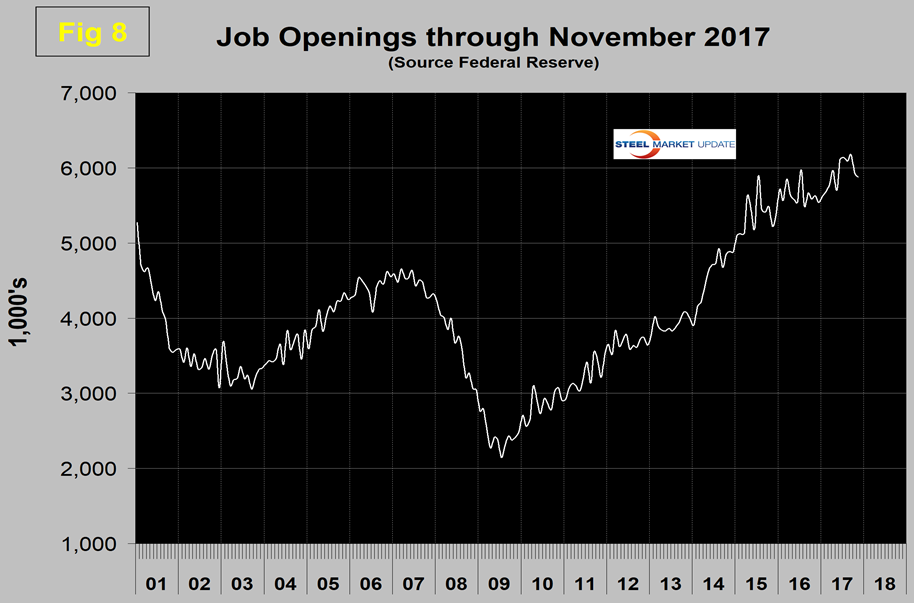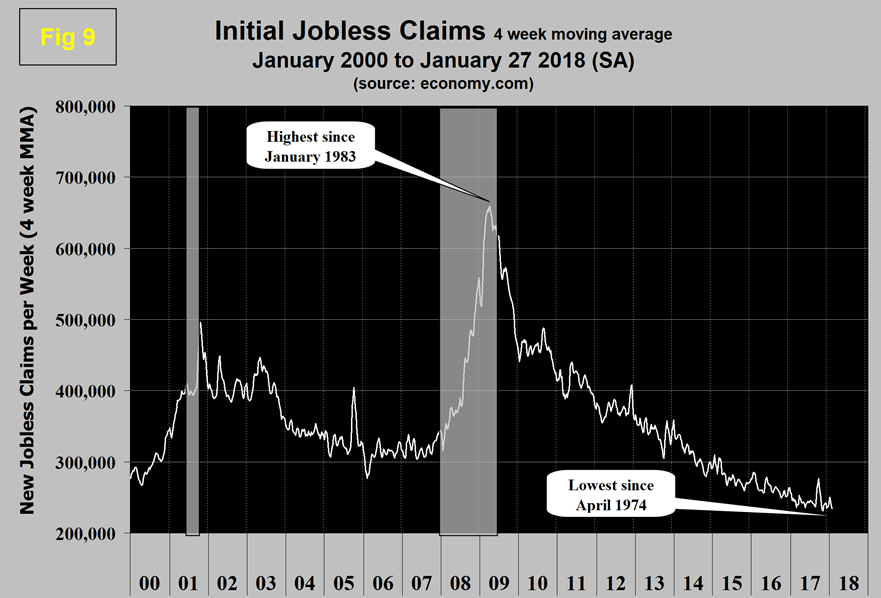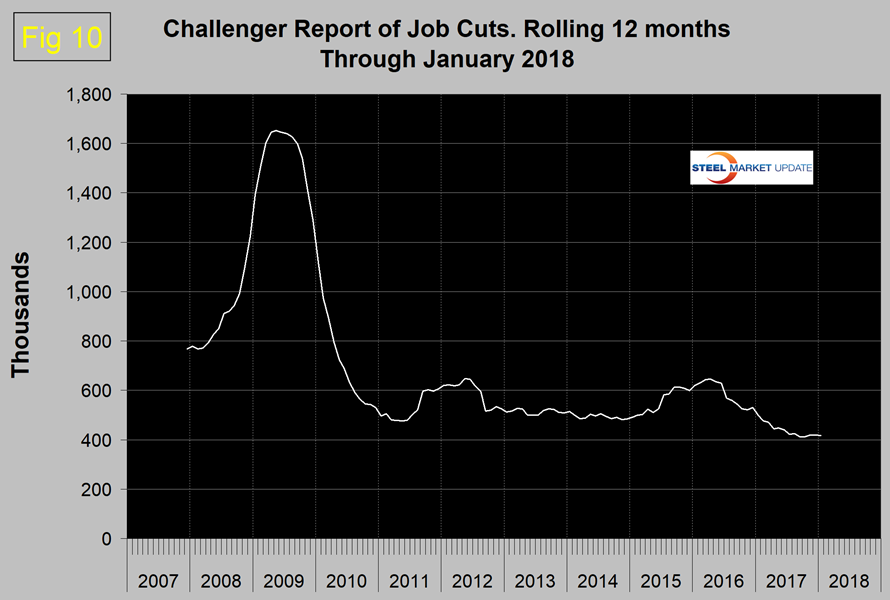Economy

BLS: January Jobs Report Paints Pretty Picture
Written by Peter Wright
February 11, 2018
The employment picture looks attractive so far for 2018, particularly for construction and manufacturing. The Bureau of Labor Statistics (BLS) reported on Friday that the economy created 200,000 new nonfarm jobs in January.
The BLS data included revisions for previous years, which we have incorporated into this update. There were increases in the total number employed at the end of the last three years—2015 was increased by 8,000, 2016 by 104,000 and 2017 by 118,000 jobs. November was revised down by 36,000 and December revised up by 12,000. Using a three-month moving average (3MMA), the January result was 192,000 jobs, down from 216,000 in December.
Economy.com reported: “The year started on a strong note with payrolls advancing by 200,000 jobs, consistent with our expectation, thanks to a partial reversal in the drop in retail and government payrolls from December. Gains were in line with those at year end in other industries. The unemployment rate was unchanged at 4.1 percent, but the underemployment rate increased to 8.2 percent. Labor force participation failed to budge, remaining at 62.7 percent. Wage growth was a tad stronger than we expected, advancing by 0.3 percent. This boosted year-over-year gains to 2.9 percent, a very welcome development.”
Figure 1 shows the 3MMA of the number of jobs created monthly since 2000 as the brown bars and the total number employed as the white line. These numbers are seasonally adjusted by the BLS, which has been criticized in the past for the ineffectiveness of its seasonal adjustment calculations.
To examine if any seasonality is left in the data after adjustment, we have developed Figure 2. In the eight years since and including 2011, job creation in January has increased by 21.0 percent. This year, it rose by 25.0 percent and therefore was historically better than average. This follows a disappointing December, which was partly a payback for October and November, both driven by the hurricane rebound and exceeding the historical performance for those two months.
Total nonfarm payrolls are now 9,445,000 more than they were at the pre-recession high of January 2008. November 2014 was the first month for total nonfarm employment to exceed 140 million and in January was 147.8 million. According to BLS data, the average workweek for all employees on private nonfarm payrolls declined by 0.2 hour to 34.3 hours in January. In manufacturing, the workweek declined by 0.2 hour to 40.6 hours, while overtime remained at 3.5 hours. The average workweek for production and nonsupervisory employees on private nonfarm payrolls edged down by 0.1 hour to 33.6 hours. In January, average hourly earnings for all employees on private nonfarm payrolls rose by 9 cents to $26.74, following an 11-cent gain in December. Over the year, average hourly earnings have risen by 75 cents, or 2.9 percent. Average hourly earnings of private-sector production and nonsupervisory employees increased by 3 cents to $22.34 in January.
Table 1 breaks total employment down into service and goods-producing industries and then into private and government employees. Most of the goods-producing employees work in manufacturing and construction and the components of these two sectors of most relevance to steel people are broken out in Table 1.
In January, 196,000 jobs were created in the private sector and government gained 4,000 jobs. The number employed by the federal government gained 5,000 to 2.8 million, state governments lost 11,000 for a total of 5.1 million and local governments gained 10,000 to reach a total of 14.41 million. Since February 2010, the employment low point, private employers have added 18,225,000 jobs as government has shed 148,000 (Figure 3).
In January, service industries expanded by 143,000 as goods-producing industries, driven mainly by construction and manufacturing, expanded by 57,000. This continues to be good news for steel demand as both steel consuming sectors have done well in the last six months. Construction has added 165,000 and manufacturing 131,000 jobs. Since February 2010, service industries have added 15,346,000 and goods-producing 2,731,000 positions. This is part of the reason why wage growth has been slow since the recession as service industries on average pay less than goods-producing industries such as manufacturing.
Table 1 shows that primary metals lost 900 jobs in January, but in the last 12 months on a percentage basis was up by more than total manufacturing. Motor vehicles and parts industries lost 300 jobs in January, but transportation equipment gained 5,700 jobs. Trucking gained 2,200 jobs in January and in the last 12 months was up by 1.0 percent. “It’s hard to find qualified drivers these days. They have other opportunities since the construction and oil markets are strong. Not many people are entering the industry” said Mark Montague of DAT Solutions in a Jan. 18 AMM article. Avery Vise of FTR Transportation Intelligence said that spot freight rates would probably continue to increase in 2018 though at a slower rate than in the last few months. Oil and gas extraction has been stalled in the last nine months with a net gain of zero since last April. Note, the subcomponents of both manufacturing and construction shown in Table 1 don’t add up to the total because we have only included those with the most relevance to the steel industry.
Construction was reported to have gained 36,000 jobs in January and is up by 3.3 percent in the last 12 months. Construction has added 1,599,000 jobs and manufacturing 1,102,000 since the recessionary employment low point in February 2010 (Figure 4). Construction has leapt ahead of manufacturing as a job creator, but the growth of construction productivity is very low, in contrast to manufacturing where it has been historically high. The difference is the difficulty of automating construction jobs.
The official unemployment rate, U3, reported in the BLS Household survey (see explanation below) came in at 4.1 percent, which was unchanged since October but down from 4.7 percent last January. This number doesn’t account for those who have stopped looking. The more comprehensive U6 unemployment rate declined from 9.2 percent in January last year to 8.2 percent in this latest report (Figure 5). U6 includes individuals working part time who desire full-time work and those who want to work but are so discouraged they have stopped looking. The differential between these rates was usually less than 4 percent before the recession, and in January it was 4.1 percent.
The employment participation rate is calculated by dividing the number of people actively participating in the labor force by the total number of people eligible to participate. This measure was 62.7 percent in January and also unchanged each month since October. Another gauge is the number employed as a percentage of the population, which we think is much more definitive. In January, the employment-to-population ratio was 60.1 percent, up from 59.7 percent in January last year and from 59.5 percent in January 2015. The employment-to-population ratio stalled for most of 2016, but has made progress in 2017. Figure 6 shows both measures on one graph.
In the 37 months since and including January 2015, there has been an increase of 7,082,000 full-time and a loss of 235,000 part-time jobs. Figure 7 shows the rolling 12-month total change in both part-time and full-time employment. This data comes from the household survey and part-time is defined as less than 35 hours per week. Because the full-time/part-time data comes from the household survey and the headline job creation number comes from the establishment survey, the two cannot be compared in any given month. To overcome the volatility in the part-time numbers, we must look at longer time periods than a month or even a quarter, which is why we look at a rolling 12 months for the full-time and part-time employment picture shown in Figure 7.
The job openings report known as JOLTS is reported on about the 10th of the month by the Federal Reserve and is over a month in arrears. Figure 8 shows the history of unfilled job openings through November when openings stood at 5,879,000, not far off the all-time high of 6,116,000 last June. There has been an improving trend since mid-2009.
Initial claims for unemployment insurance, reported weekly by the Department of Labor, flattened in 2017 except for the hurricane-driven spike. New claims are at the lowest level since 1974. In the week ending Jan. 30, initial claims were 230,000 with a four-week moving average of 234,500 claims. This marks the longest streak since 1973 of initial claims below 300,000 (Figure 9).
Another piece of the employment puzzle is the Challenger report, which measures monthly job cuts (Figure 10). This data also tends to be quite erratic; therefore, we again examine a rolling 12 months and can see that job cuts decreased for most of 2016 and continued their downward trend in 2017.
SMU Comment: Rising employment and wages are the basis of GDP growth because personal consumption accounts for almost 70 percent of GDP. Steel consumption is related to GDP; therefore, we need to be aware of changes to the employment picture. As we enter 2018, the employment situation is good, job openings are close to an all-time high, and new claims for unemployment are at a 44-year low. Manufacturing employment is 1.5 percent higher than this time last year and construction is up 3.3 percent. The employment situation has been described as “full” by some analysts. January was the 86th consecutive month of job growth, but Figure 1 shows a slowing trend since the middle of 2014. If as reported there is a shortage of qualified employees, we can expect an increase in wage-driven inflation soon. Employment growth in manufacturing and construction are signposts for steel sales activity. 2018 is starting from a strong base.
Explanation: On the first Friday of each month, the Bureau of Labor Statistics releases the employment data for the previous month. Data is available at www.bls.gov. The BLS reports on the results of two surveys. The Establishment survey reports the actual number employed by industry. The Household survey reports on the unemployment rate, participation rate, earnings, average workweek, the breakout into full-time and part-time workers and lots more details describing the age breakdown of the unemployed, reasons for and duration of unemployment. At Steel Market Update, we track the job creation numbers by many different categories. The BLS database is a reality check for other economic data streams such as manufacturing and construction. We include the net job creation figures for those two sectors in our “Key Indicators” report. It is easy to drill down into the BLS database to obtain employment data for many subsectors of the economy. For example, among hundreds of sub-indexes are truck transportation, auto production and primary metals production. The important point about all these data streams is in which direction they are headed. Whenever possible, we try to track three separate data sources for a given steel-related sector of the economy. We believe this gives a reasonable picture of market direction. The BLS data is one of the most important sources of fine-grained economic data that we use in our analyses. The states also collect their own employment numbers independently of the BLS. The compiled state data compares well with the federal data. Every three months, SMU examines the state data and provides a regional report, which indicates strength or weakness on a geographic basis. Reports by individual state can be produced on request.

Peter Wright
Read more from Peter WrightLatest in Economy

Chicago PMI dips 0.1 points in June
The Chicago Purchasing Managers Index (PMI) slipped 0.1 points to 40.4 points, in June.

Multi-family pullback drives housing starts to 5-year low in May
US housing starts tumbled in May to a five-year low, according to figures recently released by the US Census Bureau.

Architecture firms still struggling, ABI data shows
Architecture firms reported a modest improvement in billings through May, yet business conditions remained soft, according to the latest Architecture Billings Index (ABI) release from the American Institute of Architects (AIA) and Deltek.

Manufacturing in New York state contracts again
However, companies are growing more optimistic about the future.

ArcelorMittal plans wire-drawing closure in Hamilton, shifts production to Montreal
ArcelorMittal’s (AM) Hamilton location to be shuttered, wire production shifting to Montreal.

